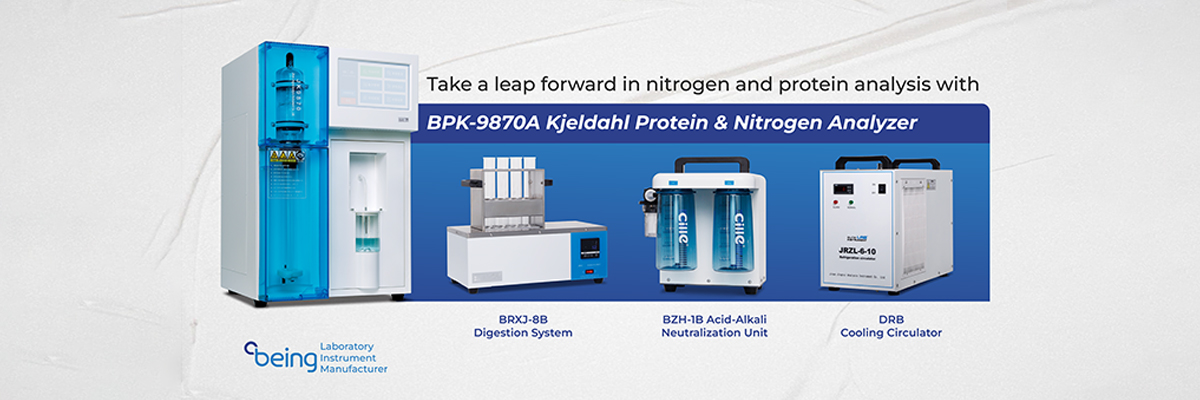Blog Standard

Exploring the Kjeldahl Method: Case Studies and Applications in Protein Analysis
Introduction:
The Kjeldahl method, also known as Kjeldahl digestion, is a fundamental technique in analytical chemistry for quantitatively determining organic nitrogen and ammonia/ammonium in samples. Developed by John Kjeldahl in 1883, this method specifically targets organic nitrogen, excluding other forms of inorganic nitrogen like nitrates unless modified. Its significance lies in the empirical relationship between Kjeldahl nitrogen and protein content, making it a crucial tool for indirectly quantifying protein in various samples.
Significance in Protein Analysis:
The accuracy of the Kjeldahl method in measuring nitrogen content is vital for determining protein levels in different samples. Since proteins consist of amino acids, which contain nitrogen, this method indirectly quantifies protein by converting the measured nitrogen content into protein content using a conversion factor. This is particularly important in the food industry for nutritional labeling and quality control, in agriculture for assessing soil and fertilizer quality, and in environmental monitoring for evaluating nitrogen pollution levels.
Background:
-
Liberation of Organic Nitrogen:
The sample is heated with concentrated sulfuric acid and a catalyst. The strong acid breaks down organic molecules, converting all nitrogen into ammonium sulfate. -
Ammonia Gas Release:
After digestion, a strong base like sodium hydroxide is added to neutralize the sulfuric acid, converting ammonium sulfate into ammonia gas -
Ammonia Gas Trapping:
The ammonia is distilled from the reaction mixture and collected in a boric acid solution, which binds with the ammonia to form ammonium borate. -
Quantification of Nitrogen:
The amount of ammonia collected is directly proportional to the nitrogen originally present in the sample. This ammonia is then quantified using titration with a standardized acid solution. The amount of acid used to neutralize the ammonia indicates the nitrogen content in the sample.
By following these steps, the Kjeldahl method allows scientists to indirectly measure the nitrogen content in various samples, such as food, soil, fertilizers, and wastewater.
Case Studies:
Optimizing Protein Content in Wheat Flour
- Problem: A wheat flour manufacturer aims to ensure consistent protein content in their product, which directly affects baking properties like dough strength and rise.
- Solution: The Kjeldahl method is employed to determine the protein content of wheat flour samples using the Being Kjeldahl analyzer.
Sample Preparation:
Flour samples are accurately weighed for analysis-
Digestion:
Each sample is digested with concentrated sulfuric acid and a catalyst in a Kjeldahl digestion apparatus. This process converts all nitrogen (mainly from proteins) into ammonium sulfate. -
Distillation and Trapping:
After digestion, sodium hydroxide is added to release ammonia gas, which is then distilled and collected in a boric acid solution Titration:
The captured ammonia in the boric acid is titrated with a standardized hydrochloric acid solution. The volume of acid used to reach the endpoint (indicated by a color change) reflects the amount of ammonia present.-
Calculation:
The nitrogen content in the sample is calculated based on the volume of standardized acid and its known concentration. A conversion factor specific to wheat flour is applied to convert nitrogen content into protein content.
Process:
High Precision and Reproducibility:
Ensures accurate and consistent resultsAutomation and Efficiency:
Streamlines the analysis process, reducing manual effort.Data Management:
Facilitates easy tracking and recording of results.High Productivity:
Increases throughput, allowing more samples to be analyzed in less time.Reliability and Ease of Use:
A user-friendly method that delivers dependable outcomes.Built-in Protein Coefficient Query Form:
Provides easy access to protein coefficients for various samples.Time-Saving:
Significantly reduces the time required for protein analysis.
Benefits of Using the Kjeldahl Method with the Being BPK9870A Analyzer:
Conclusion:
The Kjeldahl method is a valuable tool for the wheat flour industry in determining protein content and ensuring quality. Despite some limitations, it remains a reliable and widely used technique for this purpose.

